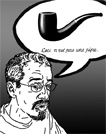Zero Sum #9. . .and #10?

If you were to visit ZSAP's current eBay auction, you would see that Zero Sum #10 was being sold.
Now, if you've been following ZSAP closely, you might have noticed that we jumped from auction #8 to auction #10. The rules for the project say that all of the sales must occur on eBay, so why the jump? Zero Sum #9 is being held back, to be sold at a later date. One of the interesting things about setting yourself up with a set of strict rules to follow when it comes to art is that you often are lead in directions that you wouldn't have predicted when you set up the rules. As I've been making the work and selling it piece by piece, I started thinking about the possibility of the Zero Sum Art Project finding a brave, forward-thinking gallery space that is willing to mount an exhibition of ZSAP artworks, while following all of the ZSAP rules, including conducting all of the sales through eBay. The exhibition would be an overview of the evolution of the imagery in the project, as influenced by the rules under which the artwork was made. It would have the unique quality of being an exhibition that exists in a specific commercial gallery, but was also available to anyone, anywhere, who is willing to bid. This will further our exploration of the mysterious alchemy that creates value in art. Ebay is a value-neutral environment, or even one which removes value from art, as it is completely unfiltered critically. Anyone with 35 cents can try to sell their work. A commercial gallery adds value to the artwork, as it represents a juried situation where time and resources have been invested in presenting artwork that is presumed to be valuable and will bring a good return for the risk taken by the gallery. By giving the artwork the cachet of a gallery setting or the uncritical setting of the eBay auction, you will change its perceived value. An exhibition that brings BOTH of these things together will be an interesting experiment.
But how did this new goal spring from those initial rules? Basically, when I started this project, I envisioned a very slow start, sort of nursing a seedling along until it became a hopefully robust plant. As the seedling was a tiny drawing made from the most mundane of materials, I imagined that the resources I would have to work with would continue to be somewhat meager. As it turns out, every auction has produced enough profit that the studio has far more supplies in "art materials" than are needed to simply replace those used by the previous piece, and I am slowly beginning to purchase my own 19th century dime museum of props from which to draw and collage. So the project logo, meant to suggest an empty money sack, may be empty of funds but it is filling with resources. I did not imagine at the outset the luxury of being able to make more work than was necessary to keep the project alive according to its strict rules of selling and spending. So, hopefully, an exhibition of works that will chronicle the growth and evolution of the imagery of the ZSAP artworks will be possible. To see whether the exhibition can exist in a bricks and mortar gallery, and simultaneously sell on eBay, will be an interesting experiment in and of itself.
There you have it. If you surf your way to the Zero Sum Art Gallery you'll find #9, in its rightful place in the sequence. The mundane titles are designed to allow a viewer to see how the artwork in the project has evolved. As of #9, they will no longer be an accurate indicator of the sequence in which the artwork was sold.
It wouldn't be any fun if ZSAP didn't just get more and more complicated, would it?






